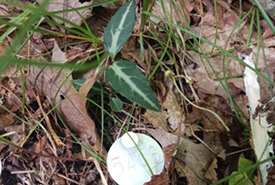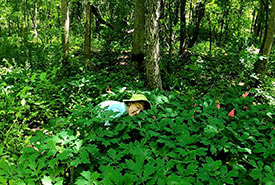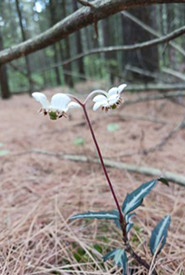NCC: Land Lines – Spotting the spotted wintergreen: Research on rare woodland plants in Ontario

A tagged spotted wintergreen plant (Photo by Amy Wiedenfeld/NCC staff)
As summer approaches, I look forward to getting out into the field. This includes visiting many of the spotted wintergreen populations in Ontario for my PhD research, supported by the Weston Family Conservation Science Fellowship Program. Spotted wintergreen is a small evergreen plant with dark green-striped leaves that flowers in late July. The small white flowers above the dark green leaves are always exciting to spot as I hike to each site, like finding treasure at the end of a treasure hunt. As one of over 75 at-risk plants in Ontario, there are few remaining populations that are primarily found in the sand plains of Norfolk county.
One step toward conserving rare plant species like the spotted wintergreen is understanding whether individual patches are growing or shrinking, and how the environment affects this. With more information on what environmental conditions the species needs, conservation efforts can focus on habitat management that will improve the chances for a population to thrive, aiding in the overall conservation of the species.

Me measuring wooded poppies. They were quite tall so I was pretty much hidden behind them. (Photo by Jenny McCune)
Of the many rare plant species in Ontario, I chose to focus on just four species in the Carolinian forest in southern Ontario for my research: spotted wintergreen, wood poppy, green dragon and goldenseal. I chose these plants both because they are interesting species and because I was able to get some previous information on all the species except for the green dragon. I’m learning more about the populations of these species and what environmental conditions they prefer, to contribute knowledge that will help inform conservation efforts.
Let me tell you more about my research on the spotted wintergreen, of which six populations are found on Nature Conservancy of Canada properties in Norfolk county.

Spotted wintergreen with flowers (Photo by Amy Wiedenfeld/NCC staff)
For this research, I visited 23 populations of spotted wintergreen last summer and placed individual markers with numbers near some of the plants. I took some basic census data for these tagged plants; recording whether or not they were flowering and the length of the longest leaf, as a size measurement. The spotted wintergreen frequently grows in pine plantations, which make for relatively comfortable fieldwork, since there is often soft pine straw to sit on while working. I will go back to measure the same plants for two more summers to see how each one grows over time — unlike with animals, I don’t have to worry about the plants going anywhere. I’m also collecting information on the environment around the plants, to better understand the habitat preferences of the species. Last summer, I collected data on soil moisture and light availability at each population, while this summer I will measure the density of plants in each population (probably taking a hula hoop into the woods for this!) and note what other plant species are in the same community.
After collecting data on the same plants for three years, I will be able to create computer models of which populations are growing or shrinking and determine if the environment influences the population trend. For example, I might learn that the spotted wintergreen prefers a certain light level for the population to grow. Conservationists can use this information to manage the habitat of spotted wintergreen so it can thrive and continue to be a beautiful flower to find in forests and pine plantations in southern Ontario.




